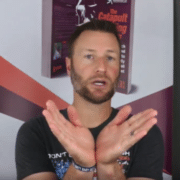How To Turn Fastpitch Softball Hitting Mechanics Into A High Level Baseball Swing…Can It Be Done?
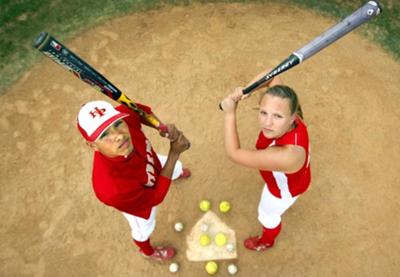
Can fastpitch softball hitting mechanics be equal to baseball?
Why is the fastpitch softball swing different than baseball? Or is it? How about vs slowpitch softball? Interesting discussion on swing plane, leg kick, launch and attack angle, ball exit velocity and bat speed. Check out this 2022 age chart for exit velocity recommendations. Quick bullets:
- Differences in Softball pitch arcs from 35 to 60-mph,
- Depending on pitch type, baseball can travel anywhere from 3-5 degrees down between 90 to 100-mph, and 6-15 degrees down at 40-85-mph,
- Optimum swing parameters for maximum distance (baseball),
- Average ball exit speed by age (baseball)…
(WARNING: this fastpitch softball hitting mechanics post is a mini-RANT, about 2,000+ words, so please set aside about a 10-min reading time)…
I received this email the other day:
“I cringe when see hitting programs that are designed by baseball players and say they teach softball hitting as a 17 year fastpitch softball coach and 26 year slow pitch player the fundamental difference in the swing many programs ignore especially when teaching fastpitch the swing has to take the most direct path to the pitched generally released at 3 to 4 feet verse a baseball is released at roughly 7 such as right view pro I’ve seen many teams and worse players swings destroyed by coaches teaching baseball to softball players please take this in account, thanks”
Before addressing this reader’s email, I wanted to mention something for those who teach fastpitch softball hitting mechanics…
Later in the post, I want to make a BIG ASK to coaches and instructors currently working with fastpitch softball hitters that are using HPL hitting principles, to please share your triumphs and/or sticking points with us.
But before we get there,
I wanted to address a couple fastpitch softball hitting mechanics points from the email above:
- Translating baseball into fastpitch softball hitting mechanics,
- Differences between the two swings?
- The BIG ASK…
Translating Baseball into Fastpitch Softball Hitting Mechanics

Who can we trust to give effective information when searching “fastpitch softball hitting mechanics” on YouTube?
The BIGGEST problem with most self-proclaimed “baseball hitting experts” online is…
They promote a hitting ‘philosophy’ or ‘theory’.
Their theories are a mish-mash of popular hitting programs, books, websites, YouTube channels, etc.
Did you know…
There’s a more certain standard – or measuring stick – that most hitting experts ignore, or just plain don’t understand?
Hitting MUST be based off human movement principles, or rules, that are validated by science…NOT philosophy or theory.
We’ve reverse engineered the hitting system promoted at the Hitting Performance Lab.
What does that mean?
Good news for coaches teaching fastpitch softball hitting mechanics…
You can bring a certain and more effective hitting standard to teaching your athletes how to hit.
And it WORKS a majority of the time!!
Beautifully.
Do you remember the first time you stumbled into an online hitting forum, discovering how much of a pissing contest it was?
The people who “seemed” to have authority on the subject of fastpitch softball hitting mechanics were coaches who:
- Had coached the longest,
- Had played the longest OR had the biggest collection of trophies at the highest level, or
- Had watched a million hours of slow motion video of ONLY ‘the best’ hitters.
Note to those who’ve coached the longest…
Someone belligerently throwing 30+ years of coaching experience in your face, most likely has the same one year of coaching experience repeated each year for 30+ years. If you’re not growing, you’re dying. And if you have to talk about how many years you’ve been coaching to desperately seek significance, then most likely your teaching has been obsolete for some time now.
You don’t hear Coaches Augie Garrido, Gordie Gillespie, or Bob Bennett lurching around online forums shoving their weight around demanding that people listen and respect them.
Note to those who’ve played the longest or have the biggest collection of trophies at the highest level…
The same lurching ego behavior can be seen, and is being used by you too.
As a matter of fact,
I just ran into an ex-pro guy last night on Facebook (I assume he was because he said he has a helluva playing resume, lol).
Brother, I hate to tell you, but…
Playing and teaching are totally different skills sets. I don’t care what your playing resume is, because you’re starting over as a coach.
Furthermore, you MUST teach the RIGHT things. The right fastpitch softball hitting mechanics.
Just because you ‘swung down on the ball’ to create backspin, DOES NOT mean that’s what actually happened if we looked at your swing using slow motion video.
I’m sorry, but what’s ‘feel’ and what’s ‘real’ are two totally different things.
Note to those coaches who accumulated a million hours watching slow motion video of ONLY ‘the best’ hitters…
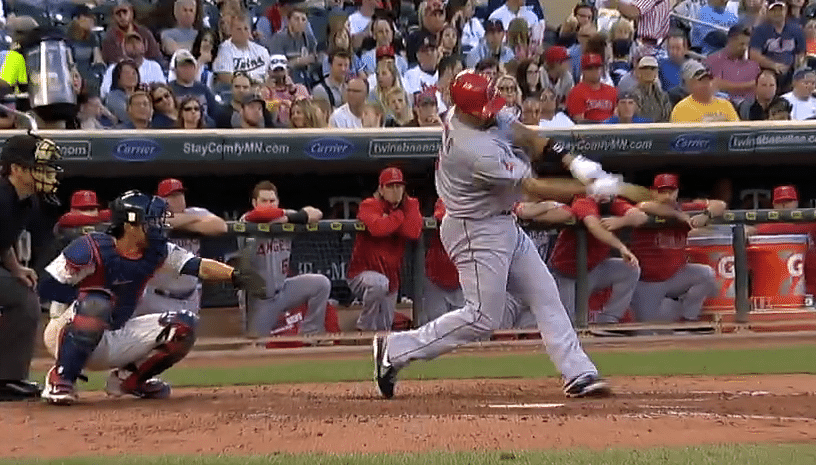
Albert Pujols photo courtesy: MLB.com
First of all, who are you studying??!
Pujols? McGwire? Griffey Jr.? Bryce Harper? Derek Jeter?
Although these hitters are and were effective in their swings, they also have, and had, ineffective human movement. I’m sorry, but what’s ‘feel’ and what’s ‘real’ are two totally different things. that MUST not be repeated by younger and/or smaller hitters.
Not just because younger hitters don’t have the capability of doing them, but because THEY SHOULD NOT be doing them, PERIOD.
In other words, they succeed, and succeeded, DESPITE elements of ineffective mechanics, NOT because of them.
Who you study is VERY important.
Big sluggers can get away with murder because of their body mass. Think of some of the BIGGER hitters you’ve come across, swimming in the fishbowl that is a Little League baseball field.
You’ll learn more of what effective fastpitch softball hitting mechanics look like from smaller sluggers like (6-feet on down):
- Sierra Romero
- Lauren Chamberlain
- Sadaharu Oh (if you don’t know who this is, you need to study up!!),
- Hank Aaron,
- Pete Rose,
- Ty Cobb,
- Josh Donaldson,
- Dustin Pedroia,
- Jose Bautista,
- Andrew McCutchen, and
- Robinson Cano.
AND by the way, video analysis is important,

Sierra Romero is a great model for the Catapult Loading System. Photo courtesy: fastpitchnews.org
But MUST come SECOND ONLY to the human movement “rules”.
Now listen close, because this is IMPORTANT to translating fastpitch softball hitting mechanics into baseball…
Once we strip away a coach/player’s elevated credentials and/or experience, then look at their analysis through the lens of human movements “rules”, that are validated by science, and it’s revealed how inconsistently ineffective their teachings really are.
They soften their system’s ineffectiveness by saying,
“Well, every hitter is different and what works for one hitter may not work for another”…OR,
“You can’t teach young hitters to do what MLB hitters are doing.”
BULL.
They’re copping-out.
But it’s not their fault.
They just don’t know any better.
They’re not growing, they’re dying.
And if you believe that what works for one hitter may not work for another, then CLICK HERE to read about the HPL One-Swing-Fits-All system. It’s not what you think it is.
The HPL hitting system works…consistently, no matter if we’re talking fastpitch softball hitting mechanics or baseball…7yo or 24yo…male or female…big or small.
We have literally thousands of coaches and parents across the nation putting into practice the HPL hitting principles, and get this…THEY ACTUALLY WORK!!
I get a steady stream of weekly emails, from coaches, sharing their success stories with the system from both the baseball and softball worlds.
(If you go to the HPL homepage, scroll all the way down to the bottom, and you’ll find over 45 rotating testimonials from these coaches and players under “Customer Testimonials”. It rotates through 5 of them at a time, then if you refresh the screen, then it’ll rotate through another 5).
The good news for the fastpitch softball hitting mechanics coach, is that credentials don’t mean a thing.
It’s outcomes.
Does your system consistently work?
Do you have a:
- 98-lb 11yo hitting the ball 300-feet, multiple times?
- 95-pounder hitting their first dinger over 270-feet? (this is actually the brother of the above hitter but 2 years younger)
- 115-lb 11yo not only hitting the ball 300-feet multiple times, but hitting over 40 homers in one season…to ALL fields?
- 66-lb 11yo hitting the ball over 180-feet? OR,
- a 115-lb 13yo hitting the ball 330-feet?
The video below is of my hitter #1 above hitting his 300-foot monster shot. Please note, he was playing on a field in Manteca, CA that had 315-foot fences, so the ‘shot’ was a long double, not a homerun. Dad played baseball at Division-1 Chico State in the late-90’s, and shared the batted ball’s estimated distance, in the following text message to me:
“This is Orin hitting the farthest ball he’s ever hit. It landed a couple feet short of the warning track in Manteca, which is right around 300-feet away”.
If you aren’t achieving these types of outcomes with your hitters, then I fear that you should rethink the effectiveness of YOUR hitting system.
Differences Between Two Swings?
Now, before getting into the differences between fastpitch softball hitting mechanics and baseball…
It should be pointed out,
That I’ve spent 10+ years in the corrective fitness industry with too many certifications to count. I’m self taught and have a passionate curiosity for the science of human movement, by people such as:
- Dr. Kelly Starrett,
- Thomas Myers,
- Ida Rolf,
- Dr. Erik Dalton,
- Dr. Serge Gracovetsky, and
- Many others…
And it’s interesting to note, that I learned more about the swing from the aforementioned people, than in all 17 years of my baseball playing career, the last four of those playing at Division-1 Fresno State!!
The bottom line is this,
There are certain ‘rules’ to human movement that are validated by science. These “rules” don’t care if you’re male or female…black or white…7 yo or 24 yo…big or small.
THEY WORK FOR ALL HUMANS!!!
The ‘rules’ are like bumpers at a bowling alley. They’re guidelines to an effective swing. What happens inside the bumpers doesn’t matter, just as long as you work within them.
Now, on the differences between the two swings…
A friend of mine since High School, made this comment on a Facebook Post of mine:
“As a former baseball player and current fastpitch softball coach. I think hitting a softball at 43ft is harder than hitting a baseball from 60ft. I’m talking about straight fastballs too, special pitches would be difficult for anyone. My first year coaching softball I had a hard time hitting a pitch. Had to adjust everything I learned from my baseball swing and vision.”
I told him, if he grew up playing fastpitch softball and hitting from the closer distances, he’d be a much better fastpitch softball hitter today!
It’s about collecting data.
The main differences in the two swings are:
- Reaction Time (or timing), and
- Knee Action.
Reaction Time (or timing)
Getting back to the original reader email, two differences they mentioned:
- “…the swing has to take the most direct path to the pitch”,
- “…the pitch is generally released at 3 to 4 feet verse a baseball is released at roughly 7″…
Look, the first issue is about reaction time.
Fast-pitch softball hitting mechanics DO NOT call for ‘shorter swings’ than a baseball player. They have to start their swings sooner!
If we start teaching hitters to ‘swing down on the ball’, be ‘short to it’, or an A to B barrel path, then we set the hitter up for inconsistent productive outcomes.
Why inconsistent productive outcomes?
Because an A to B barrel path is ineffective when looking at it through the lens of validated science:
- Centripetal v. Centrifugal Forces,
- Transferring Linear into Angular Momentum, and
- Inertial Forces changing directions.
Two priority hitting objectives, for ALL hitters, MUST be to:
- Get the barrel on the plane of the pitch as early as possible, and
- Keep the barrel on plane for as long as possible.
We coaches have to build a large margin for error into the swing, not shorten it.
WHY?
Because of a major dose of uncertainty, hitters don’t know what type of pitch is coming, its speed, or its location beforehand.
By the way, swings can still be compact without an A –> B barrel path. We MUST be teaching both hitters, more of an A –> B –> C path. My readers call the latter, the Nike Swoosh barrel path.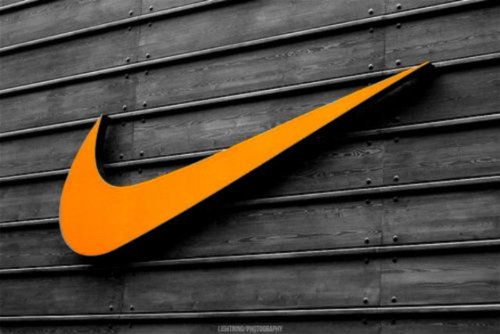
The second reader issue above has to do with the angle of the downward traveling pitch.
And YES, even a softball is traveling down by the time it reaches the hitter, thanks to Gravitational Forces and air density.
As soon as the ball leaves the pitcher’s hand (both fastpitch and baseball), the ball begins slowing down, rotating less, and ultimately falls towards the earth.
Assuming you’re still on earth 😉
Even the “Jenny Finch rise-ball begins to fall 4/5 of way, approx 8 feet away”.
However,
What is clear though, is the down angle of a fastpitch fastball isn’t quite as drastic as a baseball fastball. A fastpitch fastball just isn’t exposed to Gravitational Forces long enough.
Which is also to say, evidenced in the Sports Science video above, since there’s less distance for the softball to travel, it loses less energy than a baseball will. So that’s why we see Jennie Finch put a hurtin’ on that force plate!!
If you had the baseball pitcher throw from a distance of 43-foot, I think he’d crush the force plate as well. Just my thoughts…
So reaction time and the hitter’s barrel attack angle being different,
How does a fastpitch softball hitter manage her barrel attack angle differently than a baseball hitter?
With…
Knee Action
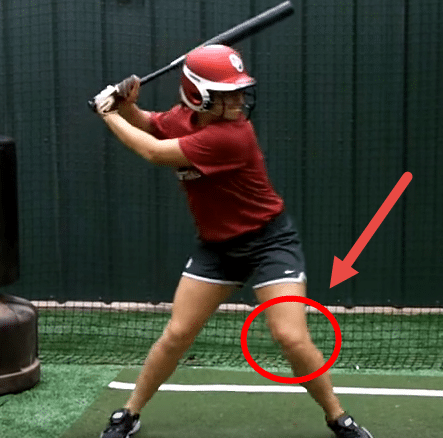
Lauren Chamberlain wide stance, but uses shifting foot pressure and HER KNEES to hit. Photo courtesy: YouTube user Paul Arebalo
In order to compensate for the slight difference in the downward angle of the pitched ball, a hitter should adjust the bending of their knees as follows…
Fastpitch hitter:
- Front knee at landing should be bent between 160 and 170-degrees (at 180-degrees, the leg is straight) to optimize Ground Reaction Forces, build in margin for error on off-speed and breaking balls, while also not giving up too much on Time To Impact.
- Back knee at impact should be bent between 105 and 115-degrees to get on path to the bottom half of the ball.
Baseball hitter:
- Front knee at landing should be bent between 150 and 165-degrees for the same reasons above, but with more access to a longer Time To Impact,
- Back knee at impact should be bent between 90 and 105-degrees to get on-path to the bottom half of the ball.
The BIG Ask…
I want to make a BIG ASK to those coaches or instructors that are currently working with fastpitch softball hitters using HPL hitting principles.
Please share your triumphs and/or sticking points below…


